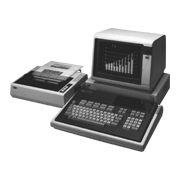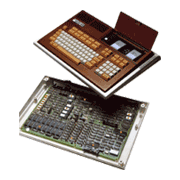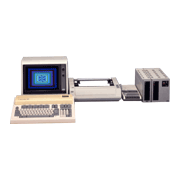This was a Fujitsu's first 8-bit personal computer (at the time it was called a "microcomputer" rather than a "personal computer"). After introducing the LKIT-8 (announced in March 1977) and the NEW LKIT-8 hobby microcomputers, Fujitsu announced the FUJITSU MICRO 8 (hereafter referred to as the "FM-8"), an 8-bit microcomputer in May 1981, as the first entry in its FM Series. The FM-8 was developed by employing innovative design and state-of-the-art semiconductor technology, and was designed for use in a variety of fields, ranging from high-level hobby use, to business applications and process control. It had the following features.
- Equipped with two Motorola 6809 8-bit CPUs (main and sub)
- (The world's first use of 64 kilobit DRAM (like that in large main frame computer) in a microcomputer (64 kilobyte main memory)
- Japanese language display using Chinese character (kanji) ROM (JIS level 1 2,965 characters, optional)
- High-resolution color graphics (640x200 dot, 8 colors selectable at each dot)
- The provided operating systems (OS) included F-BASIC, as well as UCSD-PASCAL, FLEX and CP/M (required Z80 card option)
- First use in a personal computer of bubble memory as external memory (At the time of announcement, the machine had a bubble cassette with a 32 kilobyte capacity. A 128 kilobyte cassette was added later. Bubble memory did not catch on, however, and was eliminated from the standard features in the FM-7.)
In November 1982, Fujitsu announced a upper model of the FM-8 called the FM-11, and a mass-market model called the FM-7.
The FM-7 aimed to pare down the features of the FM-8 (eliminating the bubble cassette), and thereby achieve greater compactness and a significantly lower price. The FM-7 secured a position as a hobby machine by providing a wealth of sound capabilities (3-part harmony capability using synthesizer LSI) and a diverse range of software. Later, it developed into the FM-NEW7, which used high-integration memory and gate array LSI to reduce price while maintaining FM-7 functionality, and a high-end machine called the FM-77. From the start, the FM-7/77 series emphasized high-resolution color graphics and Japanese language display, and this trend continued with AV (Audio Visual) personal computers (beginning with the subsequent FM77AV) and the FM TOWNS hypermedia personal computer. The FM-7/77 machines laid the groundwork for Fujitsu's later hobby machines.
| FM-8 | FM-7 | FM-NEW7 | FM-77 | ||
|---|---|---|---|---|---|
| Announcement date | May 1981 | November 1982 | May 1984 | May 1984 | |
| CPU | Main | 68A09(1MHz) | 68B09 (Switchable between 4.9 and 8MHz) (*1) | 68B09(8MHz) (*1) | |
| Sub | 6809 | 68B09 | 68B09E | ||
| RAM | Main memory | 64KB | 64-256KB | ||
| VRAM | 48KB | ||||
| Japanese language display | optional 40char x 12lines | Standard 40char x 12lines Optional 40char x 25lines |
|||
| Chinese character (kanji) ROM | JIS non-kanji 453 characters, JIS level 1 kanji 2965 characters | ||||
| Optional | Standard equipment | ||||
| Graphics display | 640 x 200dot | 1 screen, 8 colors | |||
| 640 x 400dot | - | Optional 1 screen, 2 colors selected from 16 colors |
|||
| Sound capabilities | - | 3-part harmony, 8 octaves | |||
| Built-in floppy disk | - | 3.5inch 320KB x1/2 | |||
| System software (Standard) | F-BASIC(ROM) | F-BASIC | |||
*1: The 68B09 (with no "E" suffix) operated with a clock frequency 1/4 the frequency of an externally connected oscillator, but the 68B09E (with the "E" suffix) operated at the frequency of the connected oscillator. In other words, the operating frequency of the 8MHz 60B09 was 2MHz, so performance was the same as the 2MHz 68B09E.




